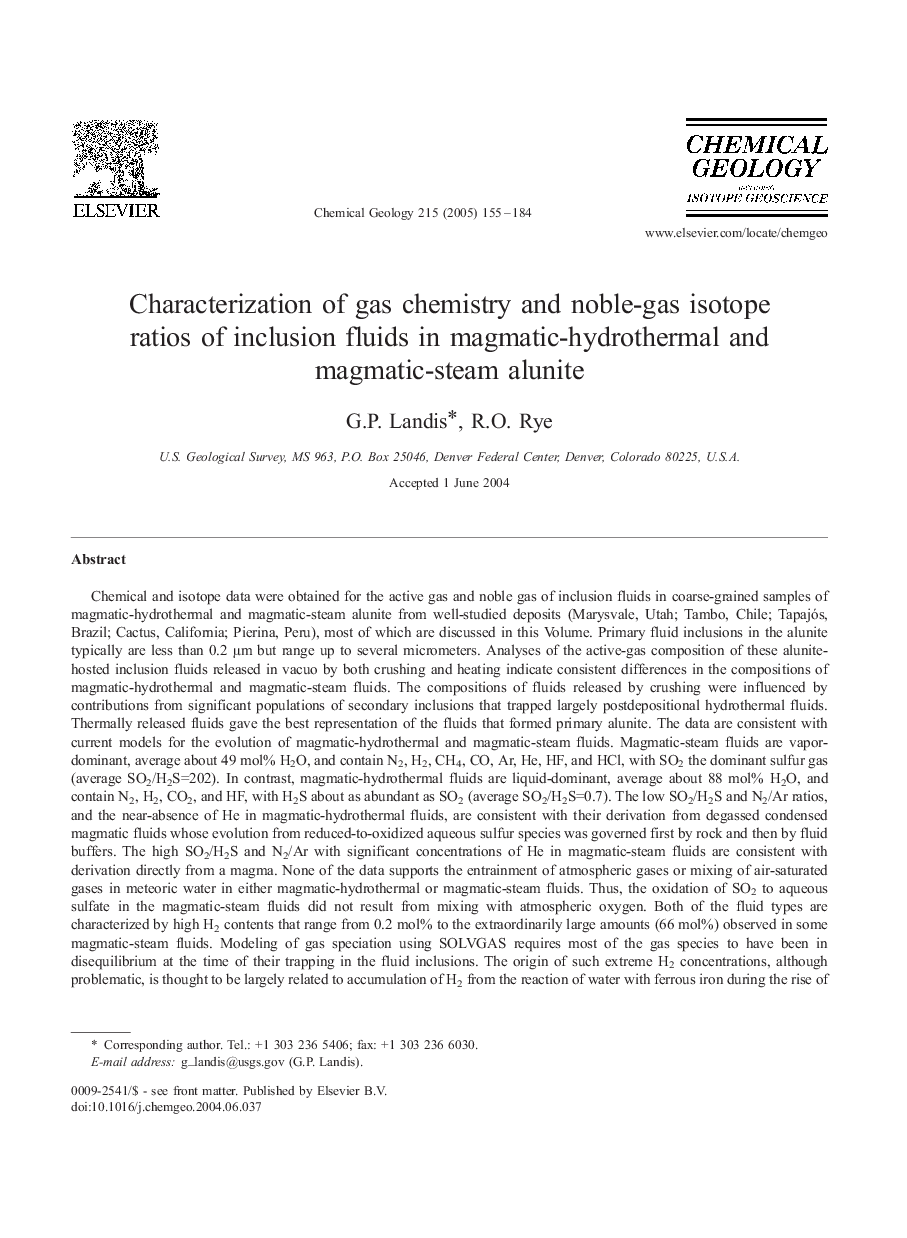| کد مقاله | کد نشریه | سال انتشار | مقاله انگلیسی | نسخه تمام متن |
|---|---|---|---|---|
| 9529212 | 1637793 | 2005 | 30 صفحه PDF | دانلود رایگان |
عنوان انگلیسی مقاله ISI
Characterization of gas chemistry and noble-gas isotope ratios of inclusion fluids in magmatic-hydrothermal and magmatic-steam alunite
دانلود مقاله + سفارش ترجمه
دانلود مقاله ISI انگلیسی
رایگان برای ایرانیان
کلمات کلیدی
موضوعات مرتبط
مهندسی و علوم پایه
علوم زمین و سیارات
ژئوشیمی و پترولوژی
پیش نمایش صفحه اول مقاله

چکیده انگلیسی
Chemical and isotope data were obtained for the active gas and noble gas of inclusion fluids in coarse-grained samples of magmatic-hydrothermal and magmatic-steam alunite from well-studied deposits (Marysvale, Utah; Tambo, Chile; Tapajós, Brazil; Cactus, California; Pierina, Peru), most of which are discussed in this Volume. Primary fluid inclusions in the alunite typically are less than 0.2 μm but range up to several micrometers. Analyses of the active-gas composition of these alunite-hosted inclusion fluids released in vacuo by both crushing and heating indicate consistent differences in the compositions of magmatic-hydrothermal and magmatic-steam fluids. The compositions of fluids released by crushing were influenced by contributions from significant populations of secondary inclusions that trapped largely postdepositional hydrothermal fluids. Thermally released fluids gave the best representation of the fluids that formed primary alunite. The data are consistent with current models for the evolution of magmatic-hydrothermal and magmatic-steam fluids. Magmatic-steam fluids are vapor-dominant, average about 49 mol% H2O, and contain N2, H2, CH4, CO, Ar, He, HF, and HCl, with SO2 the dominant sulfur gas (average SO2/H2S=202). In contrast, magmatic-hydrothermal fluids are liquid-dominant, average about 88 mol% H2O, and contain N2, H2, CO2, and HF, with H2S about as abundant as SO2 (average SO2/H2S=0.7). The low SO2/H2S and N2/Ar ratios, and the near-absence of He in magmatic-hydrothermal fluids, are consistent with their derivation from degassed condensed magmatic fluids whose evolution from reduced-to-oxidized aqueous sulfur species was governed first by rock and then by fluid buffers. The high SO2/H2S and N2/Ar with significant concentrations of He in magmatic-steam fluids are consistent with derivation directly from a magma. None of the data supports the entrainment of atmospheric gases or mixing of air-saturated gases in meteoric water in either magmatic-hydrothermal or magmatic-steam fluids. Thus, the oxidation of SO2 to aqueous sulfate in the magmatic-steam fluids did not result from mixing with atmospheric oxygen. Both of the fluid types are characterized by high H2 contents that range from 0.2 mol% to the extraordinarily large amounts (66 mol%) observed in some magmatic-steam fluids. Modeling of gas speciation using SOLVGAS requires most of the gas species to have been in disequilibrium at the time of their trapping in the fluid inclusions. The origin of such extreme H2 concentrations, although problematic, is thought to be largely related to accumulation of H2 from the reaction of water with ferrous iron during the rise of magma and probably even after exsolution of fluid from a magma. The large contents of reduced gases in the inclusion fluids are far in excess of those observed in volcanic emanations, and are thought to reflect the close “sampling position” of the host alunite relative to the location of the magma. Isotope ratios of He and Ne indicate largely crustal sources for these gases in the alunite parental fluids derived from Tertiary magmas, but a greater mantle component for the gases in alunite parental fluids derived from Proterozoic magmas.
ناشر
Database: Elsevier - ScienceDirect (ساینس دایرکت)
Journal: Chemical Geology - Volume 215, Issues 1â4, 15 February 2005, Pages 155-184
Journal: Chemical Geology - Volume 215, Issues 1â4, 15 February 2005, Pages 155-184
نویسندگان
G.P. Landis, R.O. Rye,